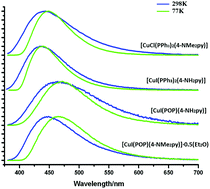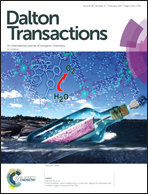A series of pure-blue-light emitting Cu(i) complexes with thermally activated delayed fluorescence: structural, photophysical, and computational studies†
Abstract
Four mononuclear Cu(I)–halide complexes containing phosphines and pyridine ligands with strong electron donor substituents, [CuCl(PPh3)2(4-NMe2py)] (1), [CuI(PPh3)2(4-NH2py)] (2), [CuI(POP)(4-NH2py)] (3), and [CuI(POP)(4-NMe2py)]·0.5(Et2O) (4), (PPh3 = triphenylphosphine, 4-NMe2py = 4-(dimethylamino)pyridine, POP = bis[(2-diphenyl-phosphino)phenyl]ether, 4-NH2py = 4-aminopyridine, Et2O = diethyl ether) were synthesized and studied with regard to their structural, photophysical properties and theoretical calculations. The complexes exhibit pure blue thermally activated delayed fluorescence (λmax = 442 (1), 436 (2), 464 (3), and 448 nm (4)) in crystalline at room temperature. Emission lifetime analyses and density functional theory (DFT) calculations show that the blue-light emission at room temperature is the singlet (metal + halide)-to-ligand charge transfer state, (1(M + X)LCT), while that at 77 K is the state of 3(M + X)LCT transition character, owing to the small singlet–triplet energy gaps (ΔE = 660–1680 cm−1). X-ray diffraction structure analysis, photophysical studies and theoretical calculations suggest that the much larger torsion angle between the N-heterocyclic rings and N–Cu–X planes of complex 3 than that of 1, 2 and 4 might causes the bathochromic shift of luminescence, although these complexes containing similar heterocycle ligands.



 Please wait while we load your content...
Please wait while we load your content...